|

Department of Energy Launches EnergyPlus 8
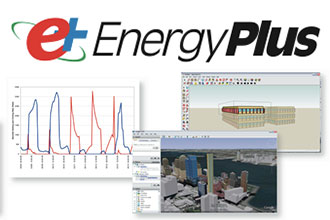 EnergyPlus is a whole building energy simulation program that engineers, architects and researchers use to model energy and water use in buildings. Modeling the performance of a building with EnergyPlus enables building professionals to optimize the building design to use less energy and water. Each version of EnergyPlus is tested extensively before release. EnergyPlus is a whole building energy simulation program that engineers, architects and researchers use to model energy and water use in buildings. Modeling the performance of a building with EnergyPlus enables building professionals to optimize the building design to use less energy and water. Each version of EnergyPlus is tested extensively before release.
EnergyPlus models heating, cooling, lighting, ventilation, other energy flows and water use. It includes many innovative simulation capabilities: time-steps less than an hour, modular systems and plant integrated with heat balance-based zone simulation, multizone air flow, thermal comfort, water use, natural ventilation, and photovoltaic systems.
EnergyPlus runs on the Windows, Macintosh, and Linux platforms. Free add-ons and other third-party software products are available for use with EnergyPlus. The details are all here [PDF].
Leave a Comment



Share Article
Back to Top

AudioControl 1600-Watt Amplifier Introduced
 The AudioControl Director D4400 is a multi-zone amplifier that drives sixteen channels of amplification and delivers 100-watts per channel, all channels driven. The D4400 features on-board digital signal processing, graphic and parametric equalization by zone, network monitoring and programming and control. It allows individual channel and zone selection via standard TCIP, the ability to bridge the channels up to 200 watts per channel and operates stable into low impedances. The AudioControl Director D4400 is a multi-zone amplifier that drives sixteen channels of amplification and delivers 100-watts per channel, all channels driven. The D4400 features on-board digital signal processing, graphic and parametric equalization by zone, network monitoring and programming and control. It allows individual channel and zone selection via standard TCIP, the ability to bridge the channels up to 200 watts per channel and operates stable into low impedances.
The Director D4400 can be connected to the network and can be controlled via browser-based user-interface to manage and control the amplifier on-site or remotely including:
- Create and name zones based on the actual configuration of the system.
- Control the amplifier set-up, configuration, monitoring and alert status.
- Calibrate graphic and parametric equalization settings that provide a acoustic room set-up for each zone with up to 128 EQ filters
- Program subsonic filters and high frequency tweeter protection circuits
- Set dual buss inputs with signal source switching over the network
- Monitor live channel status, including temperature and protection modes
- Save and recall memory settings for back-up and fast-start templates
- Group selected audio functions including muting and zone selection
- Use DHCP protocols to facilitate faster network settings and manage multiple amplifiers across the same network
- Introduce Network Device Discovery to simplify set-up via UPnP
- Allow compatibility with Class A, B and C network protocols
Here are all the specs.
Leave a Comment



Share Article
Back to Top

Peerless Hybrid EMR Cart & Other New PeerCare Products
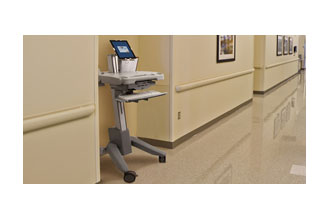 Peerless-AV’s PeerCare healthcare line includes fixed and mobile IT product mounting solutions with features that conserve space, provide maneuverability and assist in controlling the spread of infections. Peerless-AV says it offers several industry firsts, including an Electronic Medical Records (EMR) hybrid cart (available as powered and non-powered) for use with iPad, Android and Windows embedded tablets or traditional notebooks; antimicrobial wall and ceiling mounts; and medical wall mount systems. Peerless-AV’s PeerCare healthcare line includes fixed and mobile IT product mounting solutions with features that conserve space, provide maneuverability and assist in controlling the spread of infections. Peerless-AV says it offers several industry firsts, including an Electronic Medical Records (EMR) hybrid cart (available as powered and non-powered) for use with iPad, Android and Windows embedded tablets or traditional notebooks; antimicrobial wall and ceiling mounts; and medical wall mount systems.
The PeerCare EMR Hybrid Cart can be configured by the end-user into powered and non-powered platforms, giving healthcare professionals the flexibility of handling patient data on an iPad, Android, Window embedded and other thin-tablet devices or on conventional notebook computers. The powered cart, when outfitted with an optional modular three-battery system co-developed by Peerless and technology partner Belkin, remains operational through multiple nursing shifts before needing recharging. With batteries small enough to fit into a nurse’s palm, the system employs hot swappable technology that keeps an attached device fully operational even if one or two batteries are removed for recharging via an external charging cradle.
Peerless PeerCare fixed and articulating wall and ceiling mounts are integrated with Agion, a silver-fortified finish applied during manufacturing. The long-lasting, durable formulation bolsters infection control efforts, making these PeerCare antimicrobial mounts suitable for use in patient rooms and exam rooms, operating and emergency rooms, waiting areas, nursing stations and administrative offices. The series, available in both black and white, includes:
- Universal Flat Wall Mount for 10” to 102” displays, seven models
- Universal Tilt Wall Mounts for 10” to 102” displays, seven models
- Universal Articulating Wall Arms for 26” to 71” displays, three models
- Universal Ceiling Mount for 32” to 71” displays
Peerless PeerCare wall systems address the space constraints, workflow and demands typical in a healthcare environment. All of the wall systems are attachable to 10” to 26” flat panel displays and coated with an antimicrobial treatment that helps to inhibit the growth of bacteria, mold and fungus on surfaces.
The PeerCare Adaptive HT Wall System (HCW202) features a low-profile design that retracts to when folded, making suitable for hallways and other space-constrained areas. Able to accommodate sitting or standing healthcare professionals, the system can be adjusted vertically up to 12” and is easily installable.
Alternative PeerCare Wall Systems are available in heavy duty (HD) swing-arm versions (HCW201) for loads up to 35 pounds and light duty (LD) swing-arm versions (HCW202) for loads up to 16 pounds. Delivering smooth range of motion, the articulated mounts are equipped with an extended workspace above the keyboard tray and pivot limiters to prevent the system’s arms from colliding with walls. The mounts can be affixed directly to drywall with no need for studs, thus providing for a very flexible installation. Displays and keyboard trays for each mount type can be folded up against the wall when not in use, thus not encumbering patient rooms and exam areas.
Get more information on PeerCare products here.
Leave a Comment



Share Article
Back to Top

Teracue Adds RTMP Flash to ENC-300 Encoders
 Teracue AG announced today support of RTMP (Real Time Messaging Protocol) Flash streaming format for its broadcast-quality ENC-300 encoder series. The ENC-300 is a real-time, fan-less, hardware-based encoder platform. Teracue AG announced today support of RTMP (Real Time Messaging Protocol) Flash streaming format for its broadcast-quality ENC-300 encoder series. The ENC-300 is a real-time, fan-less, hardware-based encoder platform.
The ENC-300 encoder is available with DVI/HDMI or VGA/HD-SDI/analog inputs, and is specified to handle input resolutions of up to 1920×1200 using H.264 HD/SD encoder technology (embedded audio supported) for encoding/transmitting ISO-compliant H.264 HD/SD MPEG-TS transport streams.
Aimed at live events, sports broadcasting, mobile encoding and video IPTV applications, the ENC-300 series can be operated in environments from -35°C up to + 60°C. Teracue says the encoder can be up and running in 25 seconds, consumes 9 watts of power and can even be battery powered.
Here are all the technical specs.
Leave a Comment



Share Article
Back to Top

Extron’s Larger HDMI Distribution Amplifiers Ship
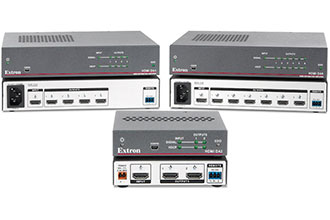 Extron has started shipping two new larger HDMI distribution amplifiers as part of its HDMI DA Series product line. The HDMI DA4 with four outputs, and HDMI DA6 with six outputs, are HDCP compliant and support data rates up to 6.75 Gbps, 12-bit Deep Color, 3D, Lip Sync and HD lossless audio formats. They also support HDTV 1080p/60, 2K and PC resolutions up to 1920×1200. For ease of integration and reliable operation, the HDMI DA Series features two Extron technologies: EDID Minder, which maintains continuous EDID communication between connected devices, and Key Minder, which continuously authenticates HDCP encryption between all devices, ensuring the simultaneous distribution of source content to connected displays. . Extron has started shipping two new larger HDMI distribution amplifiers as part of its HDMI DA Series product line. The HDMI DA4 with four outputs, and HDMI DA6 with six outputs, are HDCP compliant and support data rates up to 6.75 Gbps, 12-bit Deep Color, 3D, Lip Sync and HD lossless audio formats. They also support HDTV 1080p/60, 2K and PC resolutions up to 1920×1200. For ease of integration and reliable operation, the HDMI DA Series features two Extron technologies: EDID Minder, which maintains continuous EDID communication between connected devices, and Key Minder, which continuously authenticates HDCP encryption between all devices, ensuring the simultaneous distribution of source content to connected displays. .
The HDMI DA Series offers integrator-friendly features, including automatic input cable equalization, automatic color bit depth management and selectable output muting, as well as indicators for monitoring and troubleshooting. Input cable equalization restores and reshapes incoming HDMI signals, reducing the need for additional signal conditioning equipment by compensating for weak source signals or signal loss from a long input cable. The HDMI DA Series automatically adjusts color bit depth based on the display EDID, preventing color compatibility conflicts between source and display. Outputs can be muted independently via RS-232, allowing content to be previewed on a local monitor. Additionally, the distribution amplifiers provide immediate visual confirmation of EDID status, HDCP authentication and signal presence confirmation for each port via front panel LED indicators.
Full specs are here.
Leave a Comment



Share Article
Back to Top

Middle Atlantic Introduces Sit/Stand Functionality for ViewPoint Technical Furniture
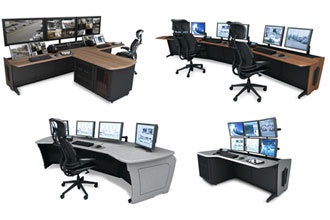 Middle Atlantic Products has just launched new height-adjustable Sit/Stand functionality for its family of ViewPoint technical furniture. Middle Atlantic says the Sit/Stand lift system functionality promotes proper ergonomics for healthy work environments, and is now available pre-installed in welded ViewPoint furniture bays or as a standalone work station model. The Sit/Stand lift legs do not intrude in equipment mounting bays, leaving the full console bay width available for equipment. Quick shipment is possible with a three-week standard lead time, the same offered for all standard ViewPoint Furniture orders. Middle Atlantic Products has just launched new height-adjustable Sit/Stand functionality for its family of ViewPoint technical furniture. Middle Atlantic says the Sit/Stand lift system functionality promotes proper ergonomics for healthy work environments, and is now available pre-installed in welded ViewPoint furniture bays or as a standalone work station model. The Sit/Stand lift legs do not intrude in equipment mounting bays, leaving the full console bay width available for equipment. Quick shipment is possible with a three-week standard lead time, the same offered for all standard ViewPoint Furniture orders.
Available in the same variety of finishes as the complete ViewPoint system, the availability of new Sit/Stand models expands the line to make an offering that is ideal and flexible for a number of situations and uses. All Viewpoint technical furniture ships fully welded for drastically reduced assembly times.
See the ViewPoint Series here.
Leave a Comment



Share Article
Back to Top

Department of Energy Debuts a Buildings Performance Database
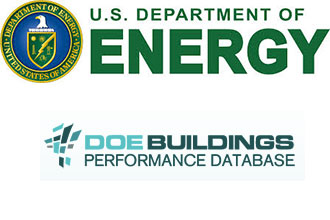 The Buildings Performance Database (BPD) from the Department of Energy is designed to ultimately make all building energy performance data public. The platform enables users to perform statistical analysis on an anonymous dataset of tens of thousands of commercial and residential buildings from across the country. Users can compare performance trends among similar buildings to identify and prioritize cost-saving energy efficiency improvements and assess the range of likely savings from these improvements. The Buildings Performance Database (BPD) from the Department of Energy is designed to ultimately make all building energy performance data public. The platform enables users to perform statistical analysis on an anonymous dataset of tens of thousands of commercial and residential buildings from across the country. Users can compare performance trends among similar buildings to identify and prioritize cost-saving energy efficiency improvements and assess the range of likely savings from these improvements.
The BPD includes:
- Actual data on tens of thousands of existing buildings — not modeled data or anecdotal evidence.
- Enables statistical analysis without revealing information about individual buildings.
- Cleanses and validates data from many sources and translates it into a standard format.
In addition, it has some analysis tools, including:
- Peer Group Tool that allows users to peruse the BPD and create peer groups based on specific building types, locations, sizes, ages, equipment and operational characteristics. Users can compare the energy use of their own building to a peer group of BPD buildings.
- Retrofit Analysis Tool allows users to analyze the savings potential of specific energy efficiency measures. Users can compare buildings that utilize one technology against peer buildings that utilize another.
- Data Table Tool allows users to generate and export statistical data about peer groups.
- Financial Forecasting Tool actually forecasts cash flows for energy efficiency projects.
- Application Programming Interface (API) that allows external software to conduct analysis of the BPD data (expect iPhone apps soon).
All the details are here.
Leave a Comment



Share Article
Back to Top

3M Exhibits New Multi-Touch Portfolio
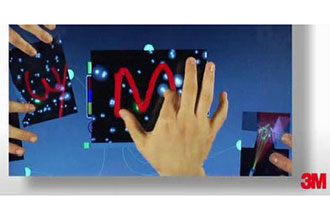 3M exhibited its latest Projected Capacitive (PCAP) multi-touch display concepts and wide product portfolio at KIOSK Europe Expo (KEX) 2013. The now available 21.5” commercial grade chassis for interactive applications was demonstrated alongside the new 46” chassis display. Visitors also had the opportunity to get hands-on with a 46” collaborative multi-touch table concept and a vertically mounted 55” multi-touch prototype display. 3M exhibited its latest Projected Capacitive (PCAP) multi-touch display concepts and wide product portfolio at KIOSK Europe Expo (KEX) 2013. The now available 21.5” commercial grade chassis for interactive applications was demonstrated alongside the new 46” chassis display. Visitors also had the opportunity to get hands-on with a 46” collaborative multi-touch table concept and a vertically mounted 55” multi-touch prototype display.
The 21.5-inch 3M Multi-Touch Display C2167PW, available since May, was exhibited at KEX showing visitors its ability to combine multi-touch performance, high-definition graphics, ultra-wide viewing angles, flat front surface product design and all-steel frame into a fully integrated, commercial grade multi-touch chassis device.
The new 46” 3M Multi-Touch Display C4667PW chassis was demonstrated as a large-format, interactive table top application to highlight new opportunities for designers and creative teams in markets such as retail, hospitality and banking. Its ultra-slim, lightweight and ruggedized open frame design allows easy integration in to applications like this, as well as kiosks and enclosures.
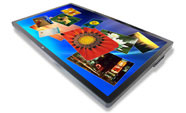 Both 21.5-inch and 46-inch high-definition 1080p LCD displays feature a wide 178-degree viewing angle (horizontal/vertical). The 21.5-inch offers 20-touch multi-touch performance for intuitive on-screen collaboration with an ultra-fast 8 ms touch response for advanced multi-touch applications. The 46-inch is capable of tracking 60 simultaneous touch events at less than 12 ms response speed with palm rejection. Both 21.5-inch and 46-inch high-definition 1080p LCD displays feature a wide 178-degree viewing angle (horizontal/vertical). The 21.5-inch offers 20-touch multi-touch performance for intuitive on-screen collaboration with an ultra-fast 8 ms touch response for advanced multi-touch applications. The 46-inch is capable of tracking 60 simultaneous touch events at less than 12 ms response speed with palm rejection.
In addition, 3M exhibited a 55” prototype display designed for ultra-large interactive applications. The display is capable of tracking 40 simultaneous touch events and, like the C4667PW chassis display, has an easy to use tablet-like user interface. It was showcased vertically mounted to demonstrate its ability to capture and maintain the attention of target consumer audiences, both from a distance and close by for multi-user experiences. This feature can help improve messaging efficiency, especially in crowded public areas such as shopping centres, hotel lobbies and convention centres.
3M also demonstrated a fully-integrated, highly-scalable PCAP system solution designed for 15” to 32” multi-touch displays. The 3M Multi-Touch System PCT2000PX combines proprietary touch screen manufacturing technology with the 3M Multi-Touch Controller PX400 to overcome existing OEM design challenges in scaling PCT solutions beyond common mobile handheld device sizes (less than 11.6 inches).
Here are the details on the new products.
Leave a Comment



Share Article
Back to Top

Arthur Holm Debuts Monitors that Open, Fold and Rotate
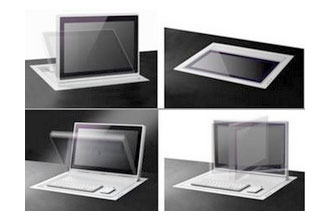 At InfoComm 2013, Arthur Holm showed the Dynamic 3, a monitor that opens, rotates 180 degrees and folds flush down to table desk level. Built with mechanized and anodized aluminum and finished with a black edged front glass, the company claims the Dynamic 3 is the only motorized or semi-automatic monitor on the market that can perform this triple feat. Dynamic 3 offers multiple HDMI and VGA inputs including HDCP compliance, flips automatically the image according to the screen position and provides a security system to stop the mechanism in case of obstruction detection. At InfoComm 2013, Arthur Holm showed the Dynamic 3, a monitor that opens, rotates 180 degrees and folds flush down to table desk level. Built with mechanized and anodized aluminum and finished with a black edged front glass, the company claims the Dynamic 3 is the only motorized or semi-automatic monitor on the market that can perform this triple feat. Dynamic 3 offers multiple HDMI and VGA inputs including HDCP compliance, flips automatically the image according to the screen position and provides a security system to stop the mechanism in case of obstruction detection.
Dynamic 3 screen’s lifting system automatically activates the elevation of an aluminum tray where keyboard can be optionally placed. An industrial PC board can also be integrated, converting the system into a work station including a multi-touch screen. All products can be personalized according to the customer requirements, by adding built in camera, speakers, fixed or motorized microphones, voting systems, USB connectors and biometric readers among others. A wide range of different colors and materials is also available.
 Arthur Holm also presented at InfoComm the option of multi-touch for its 17” BOOK monitors and has added a new 15” widescreen BOOK Full HD monitor. BOOK monitors are also built with milled and anodized aluminum with a cast iron base. They are manually foldable from 75 to 0 degrees and do not require major table desk modifications. They are designed for reception areas, meeting and board tables and auditorium since the inclination can be adjusted to any angle within its range. Arthur Holm also presented at InfoComm the option of multi-touch for its 17” BOOK monitors and has added a new 15” widescreen BOOK Full HD monitor. BOOK monitors are also built with milled and anodized aluminum with a cast iron base. They are manually foldable from 75 to 0 degrees and do not require major table desk modifications. They are designed for reception areas, meeting and board tables and auditorium since the inclination can be adjusted to any angle within its range.
A new line of Arthur Holm kiosks was also shown — an elegant information kiosks for reception areas, hotel halls, corporate lobbies and in any interior environment where information technology needs to be combined with a unique design. The structure is made of steel, finished with aluminum to 4″ of depth. The base is adjustable in height and is prepared to accept a PC. This would be in interesting up-sell in a ProAV install.
Here are all the details.
Leave a Comment



Share Article
Back to Top

Extron Ships EDID Emulator for HDMI
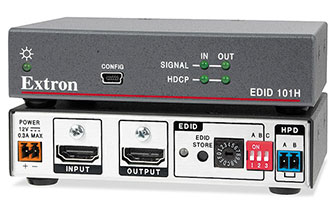 Nearly everyone has EDID (Extended Display Identification Data) issues when using HDMI, especially if you’re using different sources or different displays simultaneously. Extron is shipping its EDID 101H, an EDID emulator for HDMI signal sources. It features EDID Minder, an Extron technology designed to provide automatic and continuous EDID management, ensuring that the source powers up properly and reliably outputs content. The EDID 101H also features a unique HPD (Hot Plug Detect) port that provides control for remote cameras and other signal sources that require a periodic HPD trigger. Nearly everyone has EDID (Extended Display Identification Data) issues when using HDMI, especially if you’re using different sources or different displays simultaneously. Extron is shipping its EDID 101H, an EDID emulator for HDMI signal sources. It features EDID Minder, an Extron technology designed to provide automatic and continuous EDID management, ensuring that the source powers up properly and reliably outputs content. The EDID 101H also features a unique HPD (Hot Plug Detect) port that provides control for remote cameras and other signal sources that require a periodic HPD trigger.
The EDID 101H joins the EDID 101 Series of EDID emulators, which includes the EDID 101D for DVI and the EDID 101V for VGA signals. The EDID 101H is housed in a compact 1″ high, quarter rack width metal enclosure for convenient, discreet installation. An energy-efficient external universal power supply is included.
Here are all the specs.
Leave a Comment



Share Article
Back to Top

Planar Adds 4K 84″ LCD
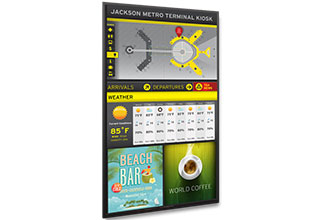 Planar’s UltraRes Series is a family of 84″ Ultra HD (3840 x 2160) pro-grade LCD displays integrated with multi-user, multi-touch technology. Planar UltraRes Touch enables six simultaneous points of touch with pinpoint accuracy and support for gesture applications across the most popular operating systems. The displays incorporate Planar’s ERO optically-bonded, low-friction protective glass which provides increased ruggedness and optical performance for applications in public spaces or interactive touch. Planar’s UltraRes Series is a family of 84″ Ultra HD (3840 x 2160) pro-grade LCD displays integrated with multi-user, multi-touch technology. Planar UltraRes Touch enables six simultaneous points of touch with pinpoint accuracy and support for gesture applications across the most popular operating systems. The displays incorporate Planar’s ERO optically-bonded, low-friction protective glass which provides increased ruggedness and optical performance for applications in public spaces or interactive touch.
The displays include up to 500 nits of brightness, can be mounted in landscape or portrait mode and are 3D capable. Planar UltraRes Series displays come with an advanced energy-efficient design that utilizes edge-lit LED technology and passive cooling. The displays can automatically switch to standby mode when no source is detected and consume less that 0.5 watt of standby power. They include no lead or mercury and are fanless in design. All are about 3″ deep.
Here are all the specs.
Leave a Comment



Share Article
Back to Top

Middle Atlantic Adds to Modular Power Raceway Line
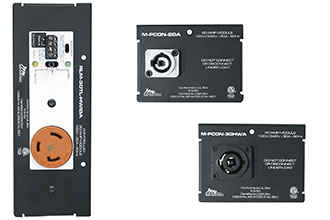 Middle Atlantic Products is expanding its MPR Series Modular Power Raceway System to include three new options: a 30 Amp controlled raceway module and two options for Neutrik powerCON connectors. If you aren’t familiar with the MPR Series, it’s an off-the-shelf NRTL-listed plug and play solution for creating a custom power strips. Middle Atlantic Products is expanding its MPR Series Modular Power Raceway System to include three new options: a 30 Amp controlled raceway module and two options for Neutrik powerCON connectors. If you aren’t familiar with the MPR Series, it’s an off-the-shelf NRTL-listed plug and play solution for creating a custom power strips.
Two Neutrik powerCON modules are available to accommodate the manufacturer’s 20-amp and 30-amp connectors. The 20-amp rated receptacle module can be incorporated into the MPR system raceway via standard MPR connectivity options, while the 30-amp version is hardwired within the raceway.
The new 30-amp controlled module brings the benefits of the MPR Series’ 30-amp controlled standalone unit into the MPR raceway. This hardwired-only option incorporates a 30-amp isolated ground twist lock receptacle. It includes a local toggle switch that allows the integrator to control the outlet status (Always On, Always Off or Dry Contact Control) and features LEDs to confirm the module’s status.
All the details are here.
Leave a Comment



Share Article
Back to Top

Vaddio Debuts IP Audio and Video Streaming Support for AV Bridge
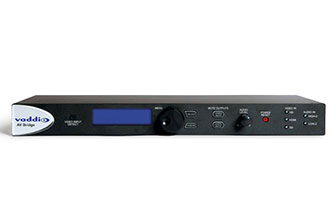 Vaddio’s AV Bridge is a room-based, HD media streaming box for USB and IP streaming of content originating from traditional audio and video equipment. The AV Bridge is designed for ProAV applications, offering a flexible audio and video interface all controllable from an embedded web server or front panel menu. A/V Bridge accepts video input resolutions from standard definition (480i/NTSC and 576i/PAL) to HD 1080p/60 in HDMI and YPbPr including wide- screen VESA type resolutions (RGBHV) and incorporates stereo audio inputs. Vaddio’s AV Bridge is a room-based, HD media streaming box for USB and IP streaming of content originating from traditional audio and video equipment. The AV Bridge is designed for ProAV applications, offering a flexible audio and video interface all controllable from an embedded web server or front panel menu. A/V Bridge accepts video input resolutions from standard definition (480i/NTSC and 576i/PAL) to HD 1080p/60 in HDMI and YPbPr including wide- screen VESA type resolutions (RGBHV) and incorporates stereo audio inputs.
The USB streaming functions using MJPEG (Motion JPEG) and standard UVC (USB Video Class) with UAC (USB Audio Class) drivers eliminating the need for installation of custom software drivers on the host PC. The IP streaming uses RTSP and encodes H.264 Audio with AAC Audio (IP streaming in Release 2.0.0). The Ethernet port currently provides access to internal web pages for control, set-up and updating the AV Bridge.
Use the AV Bridge in lecture/capture recording applications or “bridge” video and audio signals into a PC for storage, editing, rebroadcasting meetings or worship services and retrofit existing meeting rooms by simply plugging a USB cable into a host PC or connecting to an IP network.
Here are all the specs.
Leave a Comment



Share Article
Back to Top

Extron MGP Pro HDCP-Compliant Multi-Window Processors Now Shipping
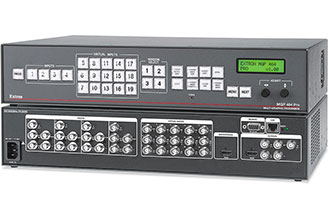 Extron’s MGP 462 Pro and MGP 464 Pro, two multi-window processors that enable the simultaneous display of multiple images on a single screen, are now shipping. Both units are HDCP-compliant on all HDMI inputs and outputs; the MGP Pro also provides two simultaneous outputs that generate HDMI and RGBHV video. Extron’s MGP 462 Pro and MGP 464 Pro, two multi-window processors that enable the simultaneous display of multiple images on a single screen, are now shipping. Both units are HDCP-compliant on all HDMI inputs and outputs; the MGP Pro also provides two simultaneous outputs that generate HDMI and RGBHV video.
To enhance and simplify integration of sources and displays, the MGP 462 Pro (two window version) and MGP 464 Pro (four window version) feature Key Minder, an Extron technology that authenticates and maintains continuous HDCP encryption between input and output devices to ensure quick and reliable switching. In addition, the MGP Pro includes Extron’s Graphic Still Store, a feature that enables screen captures of the current output, or images uploaded from a PC, to be stored for use as presentation background images. Live video from an HDMI source can also serve as the background to any presentation.
For large-scale applications, two or three MGP 462 Pro or MGP 464 Pro units may be cascaded to create displays with six to 12 windows. Optional HDMI and 3G-SDI/HD-SDI inputs enable easy integration of digital video sources into AV systems, and together with the HDMI output, allow the MGP 462 Pro and MGP 464 Pro to operate within an all-digital video system.
All the specs for the MGP Pro boxes are here.
Leave a Comment



Share Article
Back to Top

Arthur Holm Intros Gooseneck Mic Lift
 Arthur Holm’s new DynamicTalk is designed specifically as a motorized lift system for gooseneck microphones. In addition to allowing the mic to be protected and stored below a podium or desk surface, the DynamicTalk includes a mute a and talk button. Available in three different sizes, the product integrates a Dynamic LED ring to indicate the microphone status through different colors. It can be controlled via RS422 with loop through and addressing and through GPI. Arthur Holm’s new DynamicTalk is designed specifically as a motorized lift system for gooseneck microphones. In addition to allowing the mic to be protected and stored below a podium or desk surface, the DynamicTalk includes a mute a and talk button. Available in three different sizes, the product integrates a Dynamic LED ring to indicate the microphone status through different colors. It can be controlled via RS422 with loop through and addressing and through GPI.
The DynamicTalk has two different working modes — PA and conference. When in PA mode, a push button placed on the cover plate allows for activating or de-activating the microphone. The light ring will indicate the status by changing color from green to red. The system will silence the microphone when this is in retracted position. When in conference mode, the microphone will always be active and both the light ring and the access to the push button on the cover plate will be available through a connector (GPI/GPO). In this mode, the system is ready to be connected and controlled through a conference system.
Here are all the specs.
Leave a Comment



Share Article
Back to Top

Details Released on Christie Brio Wireless Room System
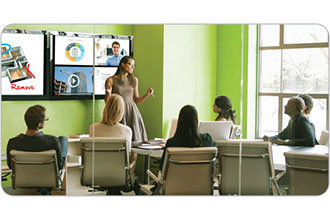 The Christie Brio is a totally wireless room system that allows up to five people to share their LCD or projection screens simultaneously. The output of Brio is two 2560×1600 (dual-link DVI-D — but can be converted to DisplayPort or HDMI) and stereo audio on 3.5 mm connectors. Inputs include up to two wired connections, five wireless inputs (from any resolution computer from 640×480 to 2560×1600 resolution), audio and all of it integrates support for HDCP. The Christie Brio is a totally wireless room system that allows up to five people to share their LCD or projection screens simultaneously. The output of Brio is two 2560×1600 (dual-link DVI-D — but can be converted to DisplayPort or HDMI) and stereo audio on 3.5 mm connectors. Inputs include up to two wired connections, five wireless inputs (from any resolution computer from 640×480 to 2560×1600 resolution), audio and all of it integrates support for HDCP.
Using Gigabit Ethernet, Christie’s Brio supports all major network protocols including IGMPv2, IPv4, IPv6, RTSP, SRTP, HTTP, TCP/IP and all wireless network streams are output at H.265 video at 30Hz. The five wireless devices are processed as network video streams @ 30Hz up to 20 Mbps per video stream.
One interesting feature of Brio that most of the other wireless room systems don’t have is the ability to connect remotely — one of the five network connection can come in remotely from another site. It also offers interactivity — the two displays at the front of the room can be multi-touch touch screens. All participants can use the interactive whiteboard to share and draw in realtime,regardless of geographic locations. Typically, one of the screens would play the content in full-screen mode while the second screen would be used to show the other four screens.
To better understand the Brio, watch this video we shot at InfoComm or read this article from the launch.
Here are all the technical specs.
Leave a Comment



Share Article
Back to Top

ComQi and Aceso Partner for Healthcare AV Market
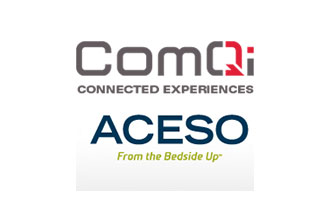 ComQi and Aceso (a healthcare management solutions provider) announced a partnership in serving the healthcare sector with turn-key digital media solutions. Basically, what’s happening is that Aceso has integrated ComQi’s Engage Content Management platform into its enterprise level UpTech platform that offers a cloud based digital media system for hospitals and healthcare facilities. The content network will be for staff, patients and visitor viewing; including patient testimonials, stories of strength and local messaging with entertaining video features, news and weather as well as informative facility information. Hospital waiting rooms, cafeterias, lobbies and lounges in a facility will be populated with interactive media solutions. It’s a market-specific digital signage network that ComQi makes and will utilize Aceso’s network to leverage getting it integrated in hospitals. It’s a good move for ComQi. ComQi and Aceso (a healthcare management solutions provider) announced a partnership in serving the healthcare sector with turn-key digital media solutions. Basically, what’s happening is that Aceso has integrated ComQi’s Engage Content Management platform into its enterprise level UpTech platform that offers a cloud based digital media system for hospitals and healthcare facilities. The content network will be for staff, patients and visitor viewing; including patient testimonials, stories of strength and local messaging with entertaining video features, news and weather as well as informative facility information. Hospital waiting rooms, cafeterias, lobbies and lounges in a facility will be populated with interactive media solutions. It’s a market-specific digital signage network that ComQi makes and will utilize Aceso’s network to leverage getting it integrated in hospitals. It’s a good move for ComQi.
In addition, ComQi and Aceso will also offer healthcare facilities interactive wayfinding solutions for touch screen kiosks and other interactive applications and entertainment.
More details are here.
Leave a Comment



Share Article
Back to Top

Matrox MuraControl 2.0 for Windows Video Wall Management Software Released
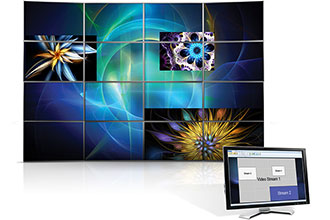 Matrox Graphics just released MuraControl 2.0 for Windows — a video wall management software for Mura-based video walls. New features include transparency and color-keying effects, the addition of local inputs and control, plus source touring and scheduling functionality: Matrox Graphics just released MuraControl 2.0 for Windows — a video wall management software for Mura-based video walls. New features include transparency and color-keying effects, the addition of local inputs and control, plus source touring and scheduling functionality:
- Transparency and color keying — Blending videos and images with the desktop, a background image, or another video is now possible by setting transparency levels for one or more windows. Source and destination color keying can also be used to enable interesting special effects, such as applying a graphic skin to a logo, or playing a video through it.
- Local application control — It is now possible to capture, display and control local VLC video and RealVNC sessions, along with Microsoft Image Viewer, PowerPoint, and Internet Explorer files. VLC videos can be set to “play” or “pause,” and PowerPoint presentations can be delivered by pressing “next” or “back”. Keyboard and mouse functionality can be sent to local applications in order to gain remote control over VNC sessions or to browse the Internet on the video wall.
- Source touring — Automated cycling through multiple sources is now supported. This feature is useful in video wall environments such as security control rooms monitoring multiple camera feeds on multiple displays, or digital signage applications featuring back-to-back ads, scaled up to fit all or part of the display wall.
- Layout scheduling — MuraControl has always allowed clients to create separate layouts showing different sources and window arrangements. With the new layout scheduling feature, those layouts can now be set to switch at specific times of the day so that the video wall can communicate different data at different times.
You can get a 21-day free trial here.
Leave a Comment



Share Article
Back to Top

Aurora Adds 8-Button Single-Gang Keypad
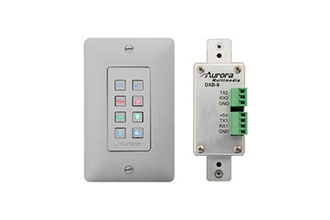 Aurora’s new DXB-8 is a low-cost, eight-button, single-gang wall keypad with two RS232 outputs. It mates with Aurora’s DXW-2 series HDBaseT Wall plates, allowing RS232 control via HDBaseT to the display over a single cable. The new button panel comes in black and white with an assortment of laser-etched backlit buttons. Aurora’s new DXB-8 is a low-cost, eight-button, single-gang wall keypad with two RS232 outputs. It mates with Aurora’s DXW-2 series HDBaseT Wall plates, allowing RS232 control via HDBaseT to the display over a single cable. The new button panel comes in black and white with an assortment of laser-etched backlit buttons.
The DXB-8 can also be used in standalone operation with each button configurable with RS232 macros, press and hold ramping features and user definable back-lit buttons in red, green and blue. With its .48″ depth, the 1-gang Decora button panel can easily be installed in the wall or table mounted.
- Eight back-lit buttons (red, green, blue)
- Two RS232 ports
- 9600-115k selectable baud rates
- Fits in standard 1-gang box
- Designed to work seamlessly with DXW-2 series HDBaseT wall plates
- Customizable laser-etched buttons
- 5vDC power (direct from DXW-2 or external PS)
- Low-depth: 0.48″ – fits in floor and table boxes
- Available in black and white
The DXB-8 ships in August and all the detailed specs are here.
Leave a Comment



Share Article
Back to Top

Christie Officially Announces 55″ with Gorilla Glass
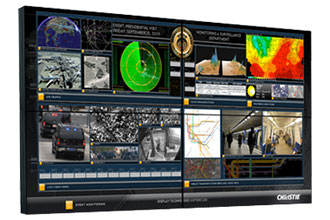 Back at ISE in January, we shot a video of the first ever showing of the Christie FHD551-XG, a 55″ LCD that is integrated with Corning Gorilla Glass (making it virtually indestructible): Back at ISE in January, we shot a video of the first ever showing of the Christie FHD551-XG, a 55″ LCD that is integrated with Corning Gorilla Glass (making it virtually indestructible):
Well, at last month’s InfoComm show in Orlando, Christie officially launched the FHD551-XG and gave us a glimpse of the specs:
- Native 1920×1080 direct-LED lit LCD using commercial glass
- Bezel thickness of 1.8-mm (bottom/right) and 3.7-mm (top/left)
- 77 nits (cd/m2) brightness
- 3000:1 contrast ratio
- Lifespan of 50,000 hours
- HDMI, DisplayPort, VGA and two DVI inputs
- Control via RS232 or RS485
Here are all the details [PDF].
Leave a Comment



Share Article
Back to Top

Crestron Adds to Commercial Wireless Lighting Control Product Line
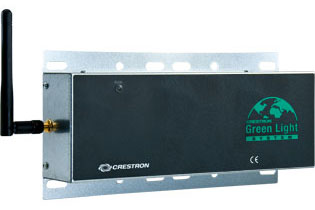 Crestron has announced several additions to its line of infiNET EX wireless lighting control products. Crestron has announced several additions to its line of infiNET EX wireless lighting control products.
The Green Light Power Pack (GLPP-EX) is an intelligent room controller available with infiNET EX wireless technology to provide quick, reliable wireless communication with a central control system. It’s designed to communicate with photocells, occupancy sensors and control stations. Part of the Power Pack family, you can start with a simple standalone system and easily expand into a centralized automation powerhouse without having to pull new wires.
The new Battery-Powered Wireless Occupancy Sensor (GLS-OIR-CSM-EX-BATT) is a low-profile occupancy sensor meant for spaces that are especially difficult to wire. It eliminates the need to homerun wires to every office in order to get sensors in. Crestron says it delivers 10 years of battery life.
 The new 2-Button Wireless Keypad (HTT-B2EX-BATT) is battery-powered, portable and designed to control a wide range of applications. It can be used as a personal workspace controller, hotel bedside controller, conference room presenter selector or a simple living room lighting/shade controller. The new 2-Button Wireless Keypad (HTT-B2EX-BATT) is battery-powered, portable and designed to control a wide range of applications. It can be used as a personal workspace controller, hotel bedside controller, conference room presenter selector or a simple living room lighting/shade controller.
These products all use Crestron’s inifiNET EX 2.4 GHz mesh network technology, which Crestron says are designed to ensure reliable communications in even the most densely populated areas where interference from wireless networks can cause intermittent signal interruption and sluggish performance. With mesh networking, each node captures and transmits its own data, as well as serving as a relay for other nodes.
For more information, click here.
Leave a Comment



Share Article
Back to Top

Extron Introduces H.264 Streaming Media Decoder
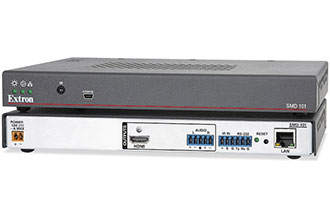 Extron’s new SMD 101 is a compact H.264 streaming media decoder used with Extron SME 100 encoders to provide complete end-to-end AV streaming systems. The SMD 101 is designed specifically for use in professional AV streaming applications to decode live AV streaming content from SME 100 encoders or to play back AV media files available from network shares. It accepts streaming resolutions up to 1080p/60 and outputs a variety of resolutions, from 640×480 up to 1920×1200. Fill/Follow/Fit aspect ratio management provides choices for managing streaming content that does not match the display. Although Extron doesn’t point this out in the press release, this could signal a move into the digital signage market as this would make a perfect DS player. Extron’s new SMD 101 is a compact H.264 streaming media decoder used with Extron SME 100 encoders to provide complete end-to-end AV streaming systems. The SMD 101 is designed specifically for use in professional AV streaming applications to decode live AV streaming content from SME 100 encoders or to play back AV media files available from network shares. It accepts streaming resolutions up to 1080p/60 and outputs a variety of resolutions, from 640×480 up to 1920×1200. Fill/Follow/Fit aspect ratio management provides choices for managing streaming content that does not match the display. Although Extron doesn’t point this out in the press release, this could signal a move into the digital signage market as this would make a perfect DS player.
The SMD 101 is adaptable to different network conditions and streaming requirements offering both push and pull streaming configurations. Audio output signals are available as HDMI embedded audio as well as analog stereo audio, making it directly compatible with embedded display speakers or existing audio systems. The SMD 101 offers integration-friendly control capabilities including an optional handheld IR remote, wired IR, RS232 or Ethernet. And a Web interface provides simple, flexible control and management.
Here are all the details.
Leave a Comment



Share Article
Back to Top

Christie Intros WU7K-J Projector for Simulation and Training Applications
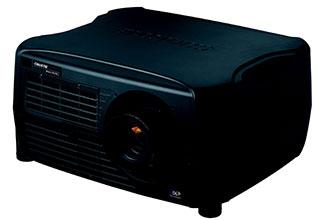 Today, Christie introduced the newest member of its Christie Matrix Series with the Christie Matrix WU7K-J 3-chip DLP projector. Featuring 6,300 ANSI lumens and WUXGA (1920×1200) resolution, the Xenon-based projector offers standard features that include full scalability, built-in geometric warping and edge blending and image processing with 120Hz capability. Today, Christie introduced the newest member of its Christie Matrix Series with the Christie Matrix WU7K-J 3-chip DLP projector. Featuring 6,300 ANSI lumens and WUXGA (1920×1200) resolution, the Xenon-based projector offers standard features that include full scalability, built-in geometric warping and edge blending and image processing with 120Hz capability.
The Christie Matrix J Series models come standard with Christie AccuFrame. Designed for simulation and training applications, Christie says this feature allows the user adjustable reduction of perceptible image smearing. It supports various frame rates and environments, ensuring the accurate display of high speed simulation content. Built-in image warping and advanced edge blending is provided by Christie Twist. It also offers RGB color matching, full control of gamma curves and greyscale tracking and minimum processing latency.
See all the specs here.
Leave a Comment



Share Article
Back to Top

Atomos Ships Samurai Blade
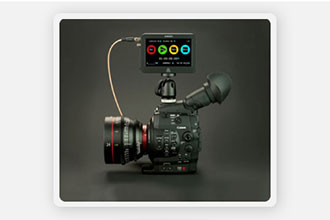 Atomos is already shipping the Samurai Blade, a 1280×720 touchscreen that allows for internal recording of 10-bit images shot with HDMI-output cameras — straight from the camera sensor directly to HDD or SSD drives, captured using Apple ProRes or Avid DNxHD codecs. Using an Atomos branded SuperAtom IPS touchscreen, at 325-ppi, 179-degree viewing, 400-nit brightness and multi-frequency (48/50/60Hz), the Blade is calibrated to SMPTE Rec 709 color space and a D65 white point with 100 percent gamut from factory. Atomos is already shipping the Samurai Blade, a 1280×720 touchscreen that allows for internal recording of 10-bit images shot with HDMI-output cameras — straight from the camera sensor directly to HDD or SSD drives, captured using Apple ProRes or Avid DNxHD codecs. Using an Atomos branded SuperAtom IPS touchscreen, at 325-ppi, 179-degree viewing, 400-nit brightness and multi-frequency (48/50/60Hz), the Blade is calibrated to SMPTE Rec 709 color space and a D65 white point with 100 percent gamut from factory.
The Samurai Blade adds essential set up tools with full waveform monitor functions, including vectorscope, RGB and LUMA parades with transparent overlay and bottom right, lower third or full screen positioning, making it an extremely flexible tool. Waveform, vectorscope and monitor assist tools such as tri-level focus peaking, zebra, false colour and blue-only offer a very comprehensive test and shot setup tool kit. The Samurai Blade has standard BNC connectors.
Here are all the details. |
Leave a Comment



Share Article
Back to Top

Sharp Launches LL-S201A 20″ MultiTouch Monitor
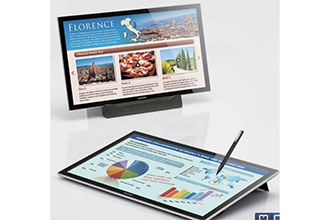 Sharp has debuted a unique-sized multi-touch LED that’s capable of being used flat, angled or handing on a wall. When flat, it can be used to mount in tables or lecterns in classrooms and when angled (75-degrees with the included stand). It can be used as a second computer monitor that’s touch-screen and interactive and when vertical, it could be used as a digital signage kiosk. Sharp has debuted a unique-sized multi-touch LED that’s capable of being used flat, angled or handing on a wall. When flat, it can be used to mount in tables or lecterns in classrooms and when angled (75-degrees with the included stand). It can be used as a second computer monitor that’s touch-screen and interactive and when vertical, it could be used as a digital signage kiosk.
The 1920×1080 resolution LL-S201A uses an edge-to-edge glass design; it weighs in at just over 5 pounds and is 1″ thick. Sharp Pen Software makes the 20″ LCD like an AQUOS BOARD Interactive Display as it’s integrated with Windows 8 compatibility and a palm cancellation function prioritizes the touch of the pen over touch – making it easy for any sized hand or user.
Here’s a brochure on the LL-S201A [PDF].
Leave a Comment



Share Article
Back to Top

Extron Ships HDCP-Compliant WindoWall Pro Series
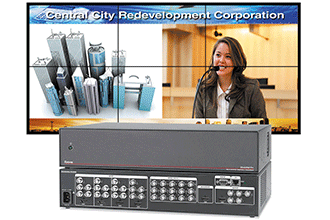 Extron is shipping its new WindoWall Pro, a four-window display video wall processing system that offers full HDCP compliance at all HDMI inputs and outputs. WindoWall Console software is the user interface to the system, facilitating control and configuration of videowall systems, and the creation of presentations with multiple, independent windows for displaying graphics, HDTV and video. Extron is shipping its new WindoWall Pro, a four-window display video wall processing system that offers full HDCP compliance at all HDMI inputs and outputs. WindoWall Console software is the user interface to the system, facilitating control and configuration of videowall systems, and the creation of presentations with multiple, independent windows for displaying graphics, HDTV and video.
Each WindoWall Pro processor allows for the display of up to four windows and employs Extron video processing technologies to scale or process real-time video outputs. Because a discrete processor is dedicated to each display unit in the videowall, WindoWall Pro is fully scalable, supporting a wide variety of display layouts from 1×2 to 2×3 and larger. The HDMI inputs, outputs and universal analog video inputs support signal rates up to 1920×1200 and HDTV 1080p/60, plus 2K on the HDMI connections. Each WindoWall Pro processor features an HDMI background input, which allows a full motion, high resolution computer-video or HDTV signal to be used as a background image to any presentation.
To help with integration, WindoWall Pro features Extron’s Key Minder that authenticates and maintains continuous HDCP encryption between input and output devices to ensure quick and reliable switching.
Here are all the specs.
Leave a Comment



Share Article
Back to Top

Christie QuadHD84 is 84″ 4K Display
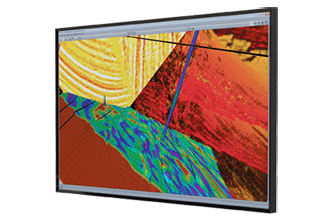 The Christie QuadHD84 is an 84″, 4K resolution (3840×2160), LED-lit LCD display that is spec’d at 350 nits (cd/m2) and a 1600:1 contrast ratio. It has the ability to display 4K content at 60 Hz — the first in the market of which we know. The Christie QuadHD84 is an 84″, 4K resolution (3840×2160), LED-lit LCD display that is spec’d at 350 nits (cd/m2) and a 1600:1 contrast ratio. It has the ability to display 4K content at 60 Hz — the first in the market of which we know.
The Christie QuadHD84 can be used as a wall-mountable or free-standing display. The native resolution of the panel is driven by four frame-locked HDMI or DVI sources at 60 Hz. The panel has three additional single-channel HDMI 1.4a inputs capable of full Quad HD resolution (3840×2160 at 30 Hz) and each of those inputs are HD-compatible, enabling graphics scaled to fill the screen at up to 60 Hz.
Here are all the specs.
Leave a Comment



Share Article
Back to Top

Sony Intros FMZ-SS Series Scalable Management Software for NSR Recorders
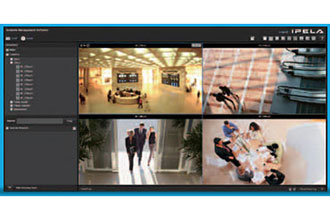 Sony’s new Scalable Management Software (SMS) is used to view and control Sony NSR and RSM recording products for security camera monitoring. It can be used to connect up to 1,000 Sony NSR-500 and/or NSR-1000 series recorders across multiple monitoring sites and allows for scalable monitoring systems – adding cameras on-the-fly. In addition, multiple site surveillance with a single system can be centralized. It’s a web-based client and includes map integration with virtual tracking feature that allows the user to associate multiple cameras in close proximity. Sony’s new Scalable Management Software (SMS) is used to view and control Sony NSR and RSM recording products for security camera monitoring. It can be used to connect up to 1,000 Sony NSR-500 and/or NSR-1000 series recorders across multiple monitoring sites and allows for scalable monitoring systems – adding cameras on-the-fly. In addition, multiple site surveillance with a single system can be centralized. It’s a web-based client and includes map integration with virtual tracking feature that allows the user to associate multiple cameras in close proximity.
In case you aren’t aware of the Sony security system, the NSR-500 is Sony’s 16-channel full-HD network surveillance recorder that’s available in two models: the NSR-500 with no internal hard disk drive (you connect your own third-party drive or perform real-time management and monitoring) and the NSR-500/4T with 4TB internal hard disk drive. The number of hard disk drive (HDD) units can be increased to achieve your required storage capacity. RAID levels can also be selected according to your precise requirements for reliability.
Here are all the details.
Leave a Comment



Share Article
Back to Top

Extron Introduces VN-Matrix 250 Encoder and Decoder for Streaming HDMI Over IP
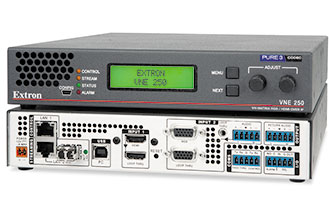 Extron’s new VN-Matrix 250 encoders and decoders provide real-time transmission of high resolution HDCP-compliant HDMI, DVI or RGB video across standard IP networks for use in real-time streaming, recording and playback applications. The VN-Matrix 250 Series accepts HDMI and RGB signals at resolutions up to 1920×1200 and 2048×1080, and streams video and audio over an IP network, preserving the native source resolution of digital or analog video sources. Stereo analog audio and HDMI-embedded audio signals are both supported, providing compatibility with embedded display speakers or existing audio systems. Extron’s new VN-Matrix 250 encoders and decoders provide real-time transmission of high resolution HDCP-compliant HDMI, DVI or RGB video across standard IP networks for use in real-time streaming, recording and playback applications. The VN-Matrix 250 Series accepts HDMI and RGB signals at resolutions up to 1920×1200 and 2048×1080, and streams video and audio over an IP network, preserving the native source resolution of digital or analog video sources. Stereo analog audio and HDMI-embedded audio signals are both supported, providing compatibility with embedded display speakers or existing audio systems.
The VN-Matrix 250 system is designed for applications like command and control, training and simulation or distance collaboration applications in government, aerospace, energy or medical environments. With its very low encode and decode latency of just 70 ms, the VN-Matrix 250 Series is ideal for applications that must support bidirectional communication and real-time decision making. The combination of high quality, low delay, and flexible bit rate management makes the VN-Matrix 250 Series the ideal solution for many quality-critical applications.
For more information on the VN-Matrix 250 Series, click here.
Leave a Comment



Share Article
Back to Top

BenQ MX661 BYOD Projector Launched
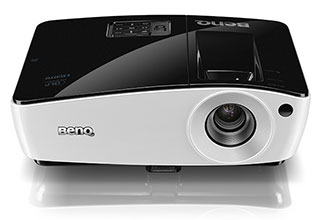 BYOD (Bring Your Own Device) is something you’ll read about a lot over the next 12 months. Why? Well, because it’s the latest buzzword and people in technology like to sound forward-thinking. So, it’s no surprise that BenQ is using the BYOD term to market the MX661′s multi-user connectivity wireless capabilities — something that’s been around for years in projectors from Barco, Christie and Sony. The MX661 is a 3000-lumen, 1-chip DLP XGA (1024×768) projector that when paired with the QPresenter app allows up to four participants to collaborate and share documents, photos and Internet content directly from their tablets to the projector. BYOD (Bring Your Own Device) is something you’ll read about a lot over the next 12 months. Why? Well, because it’s the latest buzzword and people in technology like to sound forward-thinking. So, it’s no surprise that BenQ is using the BYOD term to market the MX661′s multi-user connectivity wireless capabilities — something that’s been around for years in projectors from Barco, Christie and Sony. The MX661 is a 3000-lumen, 1-chip DLP XGA (1024×768) projector that when paired with the QPresenter app allows up to four participants to collaborate and share documents, photos and Internet content directly from their tablets to the projector.
Spec’d at 13,000:1 contrast ratio, the MX661′s inputs include VGA, HDMI and network content port. It’s integrated with BenQ’s SmartEco technology — when using the projector’s SmartEco mode, the MX661 automatically adjusts lamp power by up to 70 percent to use just the right amount of brightness, resulting in a 6,500 hours of lamp life. Another GreenAV feature is the projector’s “Eco Blank” mode that allows presenters to blank out the screen whenever projection isn’t needed, while a “No Source Detected” mode automatically lowers brightness to 30 percent when no display has been detected for more than three minutes. In “Standby” mode, the projector will lower power consumption to less than 0.5 W during periods of inactivity, providing even more energy savings.
The MX661 lists for $859 and all the detail are here.
Leave a Comment



Share Article
Back to Top

Extron Intros GreenAV Power Controller
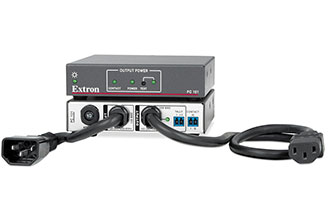 Extron’s new PC 101 is a one-input, one-output AC power controller that’s designed to provide remote power management for AV devices. When paired with a controller or control processor equipped with relays, such as the MediaLink MLC 226 IP or IP Link IPL 250, the PC 101 can be configured to turn a device ON or OFF at scheduled times for security and energy savings purposes. It features a contact closure control input and tally output, which can be used for visual feedback. The slim, compact form factor and IEC connectors on pigtails enable convenient in-line use with other devices and discrete mounting behind displays or other equipment. The PC 101 has a power rating of 100-240 VAC, 50/60 Hz, allowing for worldwide compatibility. Extron’s new PC 101 is a one-input, one-output AC power controller that’s designed to provide remote power management for AV devices. When paired with a controller or control processor equipped with relays, such as the MediaLink MLC 226 IP or IP Link IPL 250, the PC 101 can be configured to turn a device ON or OFF at scheduled times for security and energy savings purposes. It features a contact closure control input and tally output, which can be used for visual feedback. The slim, compact form factor and IEC connectors on pigtails enable convenient in-line use with other devices and discrete mounting behind displays or other equipment. The PC 101 has a power rating of 100-240 VAC, 50/60 Hz, allowing for worldwide compatibility.
Here are the product details.
Leave a Comment



Share Article
Back to Top

For all you REGULAR readers of rAVe ProAV Edition out there, hopefully you enjoyed another opinion-packed issue!
For those of you NEW to rAVe, you just read how we are — we are 100 percent opinionated. We not only report the news and new product stories of the ProAV industry, but we stuff the articles full of our opinions. That may include (but is not limited to) whether or not the product is even worth looking at, challenging the manufacturers on their specifications, calling a marketing-spec bluff and suggesting ways integrators market their products better. But, one thing is for sure, we are NOT a trade publication that gets paid for running editorial or product stories. Traditional trade publications get paid to run product stories — that’s why you see what you see in most of the pubs out there. We are different: we run what we want to run and NO ONE is going to pay us to write anything good (or bad).
Don’t like us, then go away — unsubscribe! Just use the link below.
To send me feedback, don’t reply to this newsletter. Instead, write directly to me at gary@ravepubs.com or for editorial ideas, Editor-in-Chief Sara Abrons at sara@ravepubs.com
A little about me: I graduated from Journalism School at the University of North Carolina at Chapel Hill (where I am adjunct faculty). I’ve been in the AV-industry since 1987 where I started with Extron and eventually moved to AMX. So, I guess I am an industry veteran (although I don’t think I am that old). I have been an opinionated columnist for a number of industry publications and in the late 1990s I started the widely read KNews eNewsletter (the first in the AV market) and also created the model for and was co-founder of AV Avenue, which is now known as InfoComm IQ. rAVe [Publications] has been around since 2003, when we launched our original newsletter, rAVe ProAV Edition.
Everything we publish is Opt-in — we spam NO ONE! rAVe ProAV Edition is our flagship ePublication with what we believe is a reach of virtually everyone in the ProAV market. rAVe HomeAV Edition, co-published with CEDIA and launched in February 2004, is, by far, the largest ePub in the HomeAV market. We added rAVe Rental [and Staging] in November 2007, rAVe ED [Education] in May 2008 and then rAVe DS [Digital Signage] in January 2009. We added rAVe GHGav [Green, Healthcare & Government AV] in August 2010 and rAVe HOW [House of Worship] in July 2012. You can subscribe to any of those publication or see ALL our archives by going to: https://www.ravepubs.com
To read more about my background, our team and what we do, go to https://www.ravepubs.com
Back to Top

Copyright 2013 – rAVe [Publications] – All rights reserved – All rights reserved. For reprint policies, contact rAVe [Publications], 210 Old Barn Ln. – Chapel Hill, NC 27517 – (919) 969-7501. Email: Sara@rAVePubs.com
|